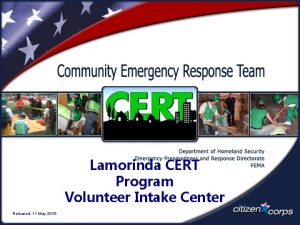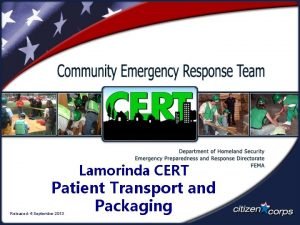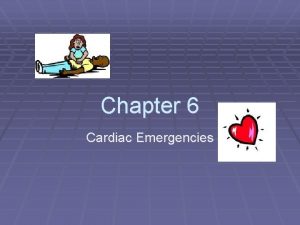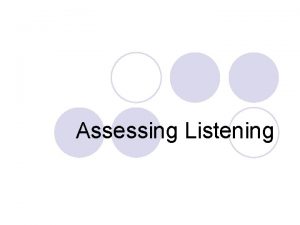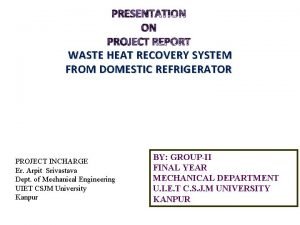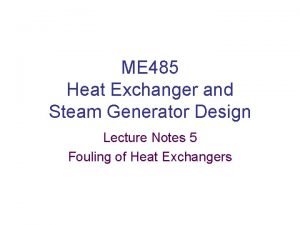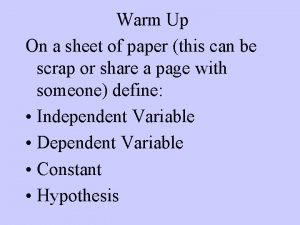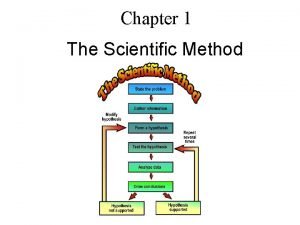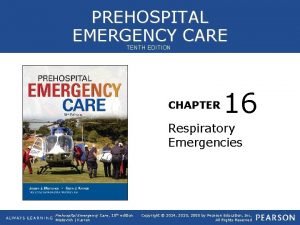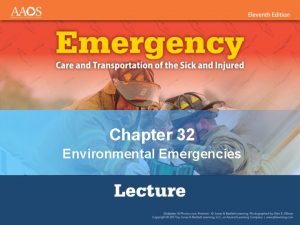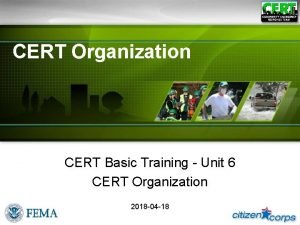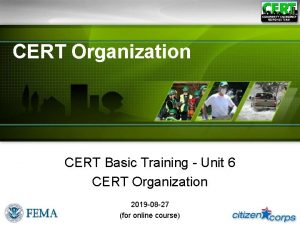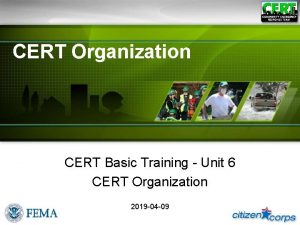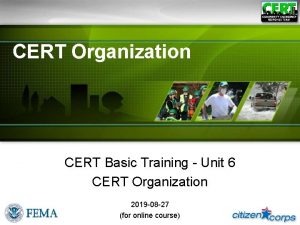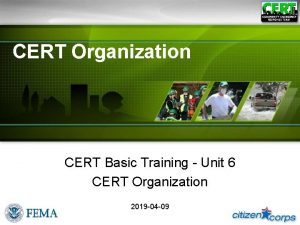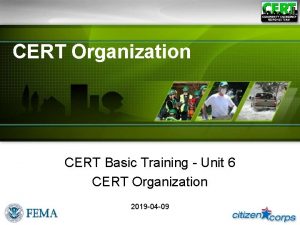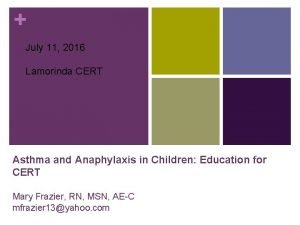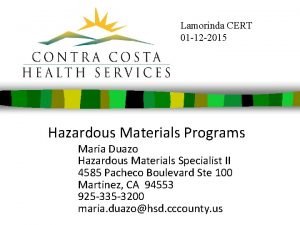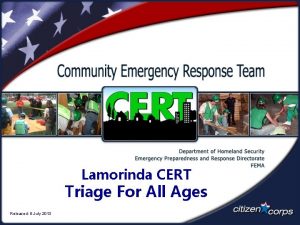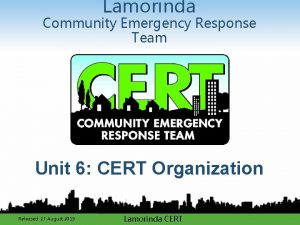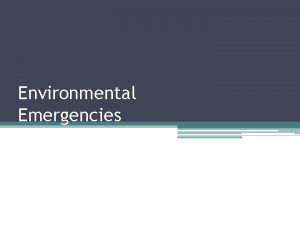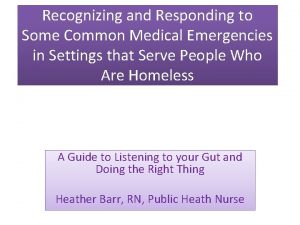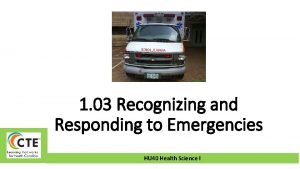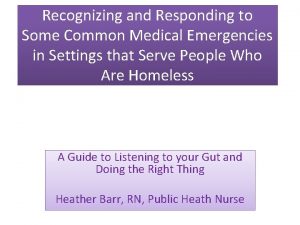Heat Emergencies Recognizing Responding and Recovery Lamorinda CERT
























- Slides: 24

Heat Emergencies Recognizing, Responding and Recovery Lamorinda CERT May 2016

The blood vessels of the dermis can dilate to contain a significant portion of the body's blood supply. This ability, along with the actions of the sweat glands, forms the body's primary temperature-regulating mechanism. The constriction or dilation of these blood vessels also affects blood pressure and the volume of blood available to the internal organs.

The nervous system controls the dilation and constriction of the blood vessels in order (amongst other things) to regulate body temp. Superficial vessels can be constricted to conserve heat or dilated to release heat, and alcohol interferes with the functioning of this system, resulting in the dilation of the superficial blood vessels. Additionally some alcoholic drinks contain high levels of chemicals like histamine (beer, red wine), which also can cause dilation of blood vessels. And dehydration can also add to the effect.

Conditions that increase susceptibility to heat-related illness include: air temperature, relative humidity, radiant heat (sun, asphalt, etc. ), conductive heat sources, air movement, activity intensity and duration, and clothing. Personal factors that affect susceptibility to heat-related illness include: age, degree of acclimatization, medical conditions (previous heat-related illness, cardiovascular disease, diabetes), water consumption, alcohol consumption, caffeine consumption, nicotine use, prescription and non-prescription medications that affect water

Lafayette Art & Wine Festival 2015 Humidity 62% Temperature 93 o Average

Heat exhaustion occurs when there is an excessive loss of water and salt in the body, usually through excessive sweating. Those most at risk are the elderly, people with high blood pressure, and those in a hot environment. What are the symptoms? • • Heavy sweating / Clammy moist skin Heavy thirst Pale or flushed complexion Panting/rapid breathing Rapid pulse Headache Nausea • • • Blurred vision Exhaustion, weakness Clumsiness Confusion Dizziness or fainting Muscle Cramps

What do you do if someone is suffering from heat exhaustion? • Move the victim to an air conditioned or cool shaded area to rest; do not leave him or her alone • Loosen and remove heavy clothing • Give cool water to drink, about a cup every 15 minutes • Fan the person, spray with cool water, or apply a wet cloth to his or her skin • Call 911 if he or she does not feel better in a few minutes


Heat stroke is the most serious heat-related illness. It happens when the body is unable to control its temperature (cool down) and the body’s temperature rapidly rises (can rise to 106 degrees or higher). This can lead to death or permanent disability if emergency treatment is not provided. What are the symptoms? • • No sweating Red or flushed, hot dry skin Any symptom of heat exhaustion but more severe Difficult breathing Pinpoint pupils Forest Jones, one of two high school football Bizarre behavior/Hallucinations players who died of Heat Stroke Aug 2, 2011 Convulsions Collapse

What do you do if someone is suffering from heat stroke? • Get medical help immediately, call 911 • Move the victim to a cool shaded area; do not leave him or her alone • Lay the person down • Loosen and remove heavy clothing • Give cool water to drink, about a cup every 15 minutes, if the person is alert enough to drink • Fan the person, spray with cool water, or wipe with a wet cloth or cover with a wet sheet • Place icepacks under the armpits and in the groin area


Cooling Centers • CERT may be asked to help operate cooling centers • If you see a person with signs of heat illness, suggest that they may want to visit the cooling center. • There will be at least one professional First Responder at the Cooling Center. This may be a Sheriff’s Deputy, an EMT or a Search & Rescue Team member. • Lamorinda Cooling Centers will have Misting Fans, cots and chairs.

Medical Monitoring Minimum conditions be screened: 1. 2. 3. 4. 5. 6. Dizzy, short of breath, weakness, nausea General complaints (cramps, aches, pains…) Signs of heat or cold-related stress Changes in gait, speech, behavior Alertness and orientation Any Vital Signs considered abnormal a. Core Temp over 100. 6 o b. Pulse > 100 c. Sp. O 2 < 92

Passive Cooling: Evaporation • Evaporation: water changing from liquid to vapor. • Even warm water will cool if it evaporates quickly • Increased humidity diminishes effect

Active Cooling: Convection • Convection: air stream directed at an object • Increased temp diminishes effect • Changes from cooling to heating above 95°F ambient air temp (the median skin temp)

Active Cooling: Conduction • Conduction: skin contact with a colder material • Cold ground, cold water, ice, snow • Water can render PPE ineffective

Active Cooling: Cold Drinks • Cold Drinks • Serves dual purpose of hydration and cooling • Ability to cool may be limited on scene • Drinks usually stored warm must be cooled or only benefit is hydration

Sports Drinks • Usually contain electrolytes and carbohydrates • Osmolarity (concentration) formulated for maximal absorption • Absorption limited by gastric emptying time (COH) • Dilution will extend gastric emptying time and lead to nausea / vomiting

Active Cooling: Cold Towels • Cold towels employ conductive • • cooling Effective in all temp and humidity levels Ice water and cold towels are the most effective method of treating exertional heat illness Surface area and location cooled are user controlled Strong psychologic appeal

Cold Towels – 3 Bucket System Bucket 1: sanitizing solution ¼ cup bleach/gallon Bucket 2: rinse Clear water removes any left over bleach Bucket 3: regeneration

Rehydration • Potable fluids to satisfy thirst on scene • Carbonated, caffeinated, high carbohydrate drinks are NOT appropriate • Encourage continuing rehydration post event

Rehydration: Truth about Caffeine • Increases urine output • Does not usually dehydrate (compensatory decline) • Consumption < 800 mg appears safe for athletes

Food • Fruits, meal replacement bars, carbohydrate drinks… • 30 -60 grams carbohydrate per hour • High fat foods inappropriate

 Lamorinda cert
Lamorinda cert Lamorinda cert
Lamorinda cert Lesson 6: cardiac emergencies and using an aed
Lesson 6: cardiac emergencies and using an aed Chapter 19 endocrine and hematologic emergencies
Chapter 19 endocrine and hematologic emergencies Emt chapter 18 gastrointestinal and urologic emergencies
Emt chapter 18 gastrointestinal and urologic emergencies Chapter 28 first aid and emergencies
Chapter 28 first aid and emergencies Useful materials and harmful
Useful materials and harmful Observing trends in entrepreneurship example
Observing trends in entrepreneurship example Recognizing opportunities and generating ideas
Recognizing opportunities and generating ideas Recognizing opportunities
Recognizing opportunities Recognizing and resolving abo discrepancies
Recognizing and resolving abo discrepancies The importance of listening in lang
The importance of listening in lang Recognizing opportunities and generating ideas
Recognizing opportunities and generating ideas Waste heat recovery project report
Waste heat recovery project report Heat recovery steam generator fouling
Heat recovery steam generator fouling Manipulated variable and responding variable graph
Manipulated variable and responding variable graph Why are line graphs powerful tools in science
Why are line graphs powerful tools in science Congratulating dialogue
Congratulating dialogue The fourth step in the scientific method is
The fourth step in the scientific method is Manipulated and responding variables examples
Manipulated and responding variables examples Making and responding to requests 2 bac
Making and responding to requests 2 bac Padi quiz 1 answers
Padi quiz 1 answers Chapter 16 respiratory emergencies
Chapter 16 respiratory emergencies Major nutritional deficiency diseases in emergencies
Major nutritional deficiency diseases in emergencies Environmental emergencies emt
Environmental emergencies emt
